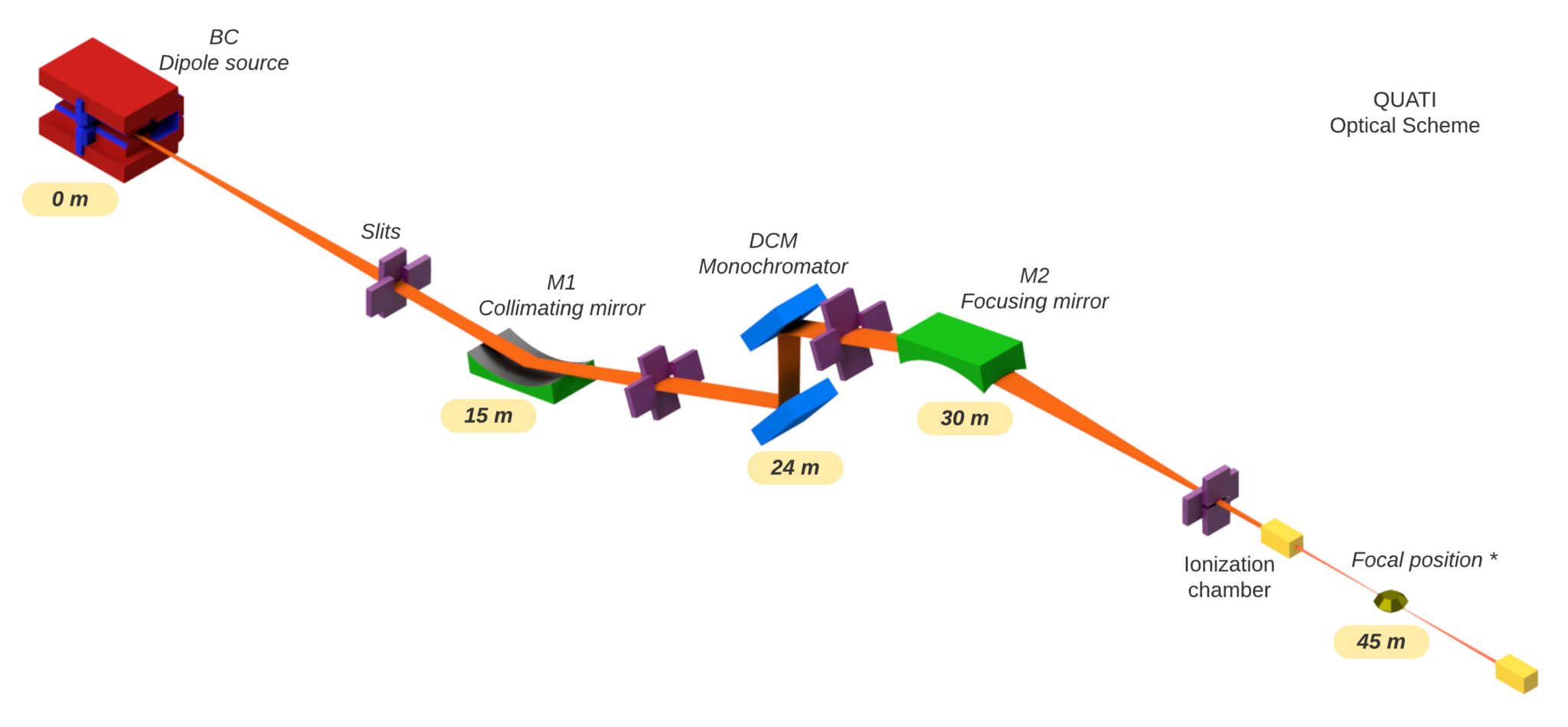CONTACT & STAFF
Facility E-mail: quati@lnls.br
Coordination: Amelie C. Rochet
Tel.: +55 19 3517 5180
E-mail: amelie.rochet@lnls.br
Click here for more information on this Facility team.
The QUATI (Quick X-Ray Absorption Spectroscopy for Time and space resolved experiments) beamline is dedicated to high-quality X-ray absorption spectroscopy experiments (XAS) with temporal and spatial resolutions.
XANES (X-Ray Absorption Near Edge Structure) and EXAFS (Extended X-Ray Absorption Fine Structure) spectra will be available between 4.5 to 35 keV (covering K edges from Titanium to Xenon and the other elements with L edges).
The high brilliance from the fourth-generation synchrotron ring SIRIUS combined with the beamline design, will allow for time-resolved measurements down to sub-second time resolution to be performed.
The beam size will be variable from 15 x 10 μm2 to 5 x 0,6 mm2. Heterogeneous and sensitive materials will largely benefit from the size flexibility.
Besides, with the high flux achieved in this beamline, it will be possible to study the structure of materials at high temperatures under gas flow or pressure under in situ / operando conditions, benefiting areas such as catalysis, materials science, nanotechnology, environmental and life sciences…
Several sample environments, such as oven (with powdered or pelletised samples), electrochemical cell, cryostat and multiple ex situ sample holders will be available. The beamline can also house sample holders brought by users.
Furthermore, the Quati beamline intends to combine X-ray techniques with other techniques to get complementary information in a single experiment. At the early stage of the beamline, mass spectrometry and Raman spectroscopy will be available. Other techniques will be implemented such as hyperspectral imaging, X-ray diffraction, X-ray emission spectroscopy and Infrared spectrometry.
Facility E-mail: quati@lnls.br
Coordination: Amelie C. Rochet
Tel.: +55 19 3517 5180
E-mail: amelie.rochet@lnls.br
Click here for more information on this Facility team.
For the current call, the Quati beamline is not yet open for commissioning proposals.
The technical commissioning steps on the beamline are progressing well, and the first experiments with users are expected during the second semester of 2025. The experimental station is in the final installation phase and started its technical commissioning.
Researchers are required to contact the beamline staff before submitting a proposal.
Figure 1 presents the optical design of the Quati beamline. The primary source of Quati is a 3.2 T superbend, a permanent dipole that generates hard X-rays with a critical energy of 19.15 keV. The main optical elements of the QUATI project are a collimating mirror (M1), a double crystal monochromator (DCM), and a focusing mirror (M2).

| Element | Type | Position [m] | Description |
|---|---|---|---|
| Source | Magnetic dipole | 0 | 3.2 T |
| M1 | First mirror | 15 | Vertical collimation, 2.25 mrad. Plane mirror. Stripes: Rh, Pt, Si. |
| DCM | Double Crystal Monochromator | 24 | Monochromatization |
| M2 | Second mirror | 30 | Vertical and horizontal focalization, 2.25 mrad. Toroidal mirror. Stripes: Rh, Pt. |
| Parameter | Value | Condition |
|---|---|---|
| Energy range | 4.5 – 12 keV 8 – 35 keV |
Si (111) Si (311) |
| Energy resolution (ΔE/E) | 10−4 10−5 |
Si (111) Si (311) |
| Photon flux | 1011 photons . s-1 @100 mA 1010 photons . s-1 @100 mA |
Si (111) Si (311) |
| Beam size | 15 x 10 μm2 up to 5 x 0.6 mm2 | The smaller beam size at 45 m, and the larger one at 48 m. |